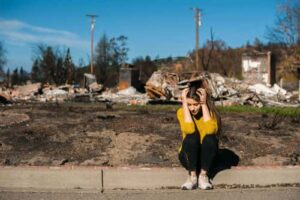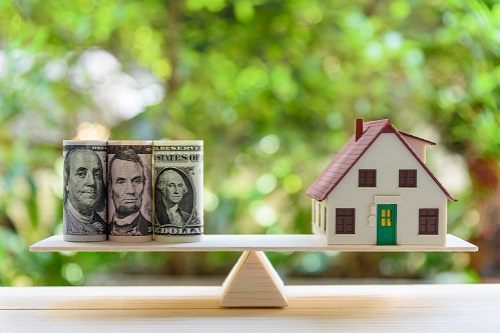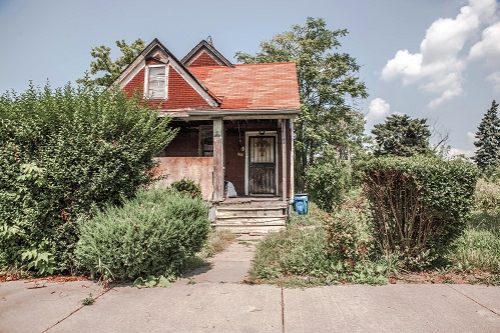- Do Americans have enough insurance for a natural disaster?
- We asked homeowners: Do you feel your insurance is sufficient for a natural disaster?
- Do homeowners have enough insurance for a hurricane?
- Do homeowners have enough insurance for a flood?
- Do homeowners have enough insurance for a wildfire?
- Do people have enough insurance for an earthquake?
- How can you find affordable insurance with rising rates?
- How to insure your home against natural disasters
Do Americans have enough insurance for a natural disaster?
In 2024, the National Oceanic and Atmospheric Administration (NOAA) reported 27 billion-dollar climate and weather events totaling more than $182 billion in damage. Since 1980, there have been 341 $1 billion-plus disasters with a cumulative total of $2.915 trillion in damages.
Not all of those damages were covered by insurance, for reasons including people not carrying the right coverage, not carrying enough coverage, or simply not understanding what’s covered by insurance. It’s easy to become underinsured over time.
“Inflation, supply chain issues and increased demand for skilled labor and construction materials following several years of unprecedented natural disasters have all contributed to a significant increase in the costs and timeframes to rebuild homes and businesses,” says Karen Collins, vice president of property and environmental at the APCIA.
“Homeowners and business owners need to ensure the coverage provided by their insurance policy is keeping pace with these elevated costs,” she says. “There are key additional coverage features, such as automatic inflation guard, extended replacement cost, and building code/ordinance coverage, that property owners can consider to help prevent being underinsured.”
Losses that aren’t covered by insurance often come as a surprise to homeowners.
“Most consumers assume their home insurance policy includes flood coverage, but it doesn’t. In fact, only 4% of U.S. homeowners carry flood insurance, which is the largest insurance gap across the country,” Friedlander says.
We asked homeowners: Do you feel your insurance is sufficient for a natural disaster?
Insurance.com editors asked survey respondents if they feel their insurance sufficiently protects them from several common natural disasters:
- Hurricanes
- Floods
- Earthquakes
- Wildfires
Not everyone feels confident in their coverage, but survey respondents indicated that they are most confident in their insurance coverage when it comes to floods: 89% of those who have flood insurance feel protected. They were least confident in their coverage regarding wildfires, with only 55.4% saying they feel protected.
Meanwhile, 78% of people living in a hurricane-prone area say they’re confident in their coverage, and 64.4% of those who feel they’re at risk of an earthquake say they feel well-protected.
Is their confidence in their insurance misplaced, or should more people feel confident? Experts say many are actually underinsured.
“Bridging preparedness and insurance gaps requires a change in the way we all think about natural disasters. Too often, people overestimate their preparedness for natural disasters and other emergencies, and this can lead to gaps in preparedness and insurance coverage,” Collins says.
We compared our survey responses to the reality of coverage needs for each type of natural disaster.
Do homeowners have enough insurance for a hurricane?
Proper insurance for a hurricane requires more than one policy to create cohesive coverage. Homeowners insurance does cover hurricane damage, including from wind, falling trees and water damage other than a flood.
“Standard home insurance policies include coverage for windstorm damage, including hurricanes. Homeowners in hurricane-prone states should conduct an insurance checkup with their agent to ensure they have an adequate level of dwelling replacement coverage (called “Coverage A” in an insurance policy) to account for rising replacement costs of homes,” Friedlander says.
Without flood insurance, however, you are not covered for overland flooding, which includes storm surges or heavy rainfall that causes a river or lake to overflow or flash floods.
“The biggest insurance gap we see for homeowners prone to hurricane damage is lack of flood coverage. Most homeowners assume their hurricane coverage includes floods, which it doesn’t. Flood insurance is a separate coverage available through either the National Flood Insurance Program or dozens of private flood insurers,” Friedlander says.
Our survey found that less than a third of respondents have flood insurance, and we also found a number of people who, in the past year, have canceled their flood insurance due to rising costs.
However, almost 78% of respondents who reported living in a hurricane-prone area felt confident their home insurance will cover them. Of those:
- 27% weren’t sure if their policy has a hurricane deductible
- 22% said they don’t have a hurricane deductible
- The remaining 51% are sure they do have a hurricane deductible
While not having a hurricane deductible doesn’t always mean you’re not covered for hurricanes, it does in some cases. It also often means you’ll pay more for coverage since the insurance company is carrying more of the cost burden in a claim. In all cases, it’s important to know what your deductibles and coverage are.
Flood insurance is an important component of coverage for a hurricane. Without it, damage from overland flooding will not be covered. In the three Gulf Coast states that see the most hurricanes, Florida, Louisiana and Texas, less than half of respondents have flood insurance.
- 44.4% of those polled in Louisiana have flood insurance
- 42.7% of those polled in Florida have flood insurance
- 37.6% of those polled in Texas have flood insurance
In all three states, homeowners have a high level of confidence in their flood insurance:
- 100% of those polled in Louisiana with flood insurance feel adequately protected
- 90.2% of those polled in Texas with flood insurance feel adequately protected
- 85.1% of those polled in Florida with flood insurance feel adequately protected
Let’s take a closer look at flood insurance.
Do homeowners have enough insurance for a flood?
Homeowners insurance doesn’t cover floods, a fact that many people find out when it’s too late. Hurricane Helene shone a light on how important flood insurance is.
Helene's torrential rainfall caused massive flooding in areas not usually prone to hurricane damage, particularly in western North Carolina, where it is estimated than less than 1% of homes had flood insurance. Of the estimated $250 billion in damage done, only about $5 billion is covered by insurance, PBS reported.
Many people think they don’t need flood insurance if they’re not in a high-risk area. However, the NFIP sees more than 25% of claims from homeowners living outside flood zones. Although mortgage companies require flood insurance for homes that are considered high-risk, such as waterfront homes, a storm surge like the one that accompanied Hurricane Ian can reach far inland and destroy homes that aren’t considered high-risk.
“All areas of the U.S. are prone to severe flooding, not just FEMA-designated flood zones. Ninety percent of natural disasters involve flooding. Over the past year, we have experienced catastrophic floods in inland areas, including Eastern Kentucky, the St. Louis metro area and Vermont. These floods were caused by torrential rainstorms, not hurricanes or tropical storms,” Friedlander says.
Still, only about a third of homeowners have flood insurance nationwide, according to our home insurance survey. That’s higher than other estimates (the Insurance Information Institute estimates 4% have flood insurance, per Friedlander,) but still below the number of people who likely need it. Here’s what our respondents had to say about flood insurance:
- 32.6% of those polled nationwide have flood insurance, indicating our sample has a higher-than-average rate of flood coverage
- 89.2% of those with flood insurance nationwide feel like their policy has them adequately protected in the event of a flood
Of the people polled in Florida, Louisiana, New Jersey, New York and Texas, where FEMA reports paying 75% of flood claims nationwide, the numbers weren’t as high as expected.
- 39.6% of those polled have flood insurance
- 12.4% of those polled in the same five states have dropped flood insurance due to cost; 16% in New York, and 14.7% in Texas
- 88.9% of those polled in these five states believe their insurance has them adequately protected from a flood
Of course, not all areas of a state are at high flood risk, especially in large states like Texas, which may explain the lower-than-expected number of people with flood insurance. People tend not to buy flood insurance if they aren’t in a high-risk area, in spite of the fact that floods frequently happen outside of those areas.
Read more on the flood insurance claims process.
Do homeowners have enough insurance for a wildfire?
Wildfires are an increasing danger to homes and property; in California alone, 1.2 million homes are at risk of wildfire per the Insurance Information Institute.
Homeowners insurance does cover wildfire damage, but in some parts of the western states, including California and Colorado, home insurance is becoming more expensive and harder to find, and there are some possible exclusions.
“Standard home policies typically cover wildfire damage. There may be some exceptions in high-risk areas, so it’s best to check with your insurance agent to make sure you are protected from wildfires,” Friedlander says.
Our survey found that just over 55% (55.4%) of people surveyed feel their home insurance is enough to protect them from a wildfire loss. That means about 45% (44.6%), less than half don’t think they have enough coverage.
“The low response number [of people who are confident] could be caused by the fact that a significant amount of homeowners are not sure whether damages caused by wildfire are covered,” says Dr. Haibo Stephen Yao, assistant professor of insurance and risk management, University of Central Arkansas.
America’s Emergency Preparedness Report Card’s States at Risk report lists Arizona, California, Nevada and Texas as the four states most at risk of increasing wildfire damage. In those states, the following percentage of homeowners in the survey feel they have enough insurance:
- 69.9% of Californians
- 60.5% of Arizonians
- 51.4% of Texans
- 40% of Nevadans
The most likely reason for not having enough coverage for wildfire damage is underestimating or not updating the replacement cost coverage for your home. Many people avoid increasing that coverage because it means higher premiums, but if the day comes that the house is burned to the ground, that extra premium will be a small expense compared to what you’ll be out of pocket if you don’t have enough coverage.
“Since the start of the COVID-19 pandemic, the price of single-family residential home construction materials rose by 35.4% while labor costs rose by 30% (January 2020 through June 2023). However, a 2022 APCIA/Harris Poll survey found that only 30% of insured homeowners have purchased more insurance or increased coverage limits to compensate for rising building costs. Additionally, among insured homeowners who completed renovations or remodels during the COVID-19 pandemic, only 40% updated their home insurance to account for those changes, which may leave them underinsured in the event of a loss,” Collins says.
Do people have enough insurance for an earthquake?
Earthquakes can happen just about anywhere, but they’re most common and most destructive in states along the West Coast.
We asked homeowners whether they feel they’re exposed to earthquake risk and how they feel their insurance will protect them if a quake strikes.
- 47.7% of respondents nationwide feel they are not exposed to earthquake risk where they live
- Of those respondents nationwide who feel they are exposed to earthquake risk, 64.4% feel adequately protected by their homeowners insurance policy
- All respondents in Alaska and Hawaii feel that they are exposed to earthquake risk
- All Alaskans said they had enough insurance, but only 60% of Hawaiians said the same
- 9.56% of Californian respondents feel they are not exposed to earthquake risk where they live
- 65% of Californians who feel they are exposed to earthquake risk said they feel they have enough insurance
- 46.67% of respondents in Nevada feel they are not exposed to earthquake risk where they live
- 75% of Nevadans who feel they are exposed to earthquake risk said they feel they have enough insurance
- 25% of respondents in Washington feel they are not exposed to earthquake risk where they live
- 83% of Washingtonians who feel they are exposed to earthquake risk said they feel they have enough insurance
Of the people who said they feel adequately protected from an earthquake, less than half – 45% – have earthquake insurance. That’s bad news for the nearly 55% who believe they’re protected.
“Unless [they purchase] separate earthquake coverages in the form of [an] endorsement by paying extra insurance premiums, most homeowners get no coverage for that,” Yao says.
Earthquake damage is not covered by standard homeowners insurance; earthquake insurance is sold as an endorsement by most home insurance companies. Some companies also sell standalone policies. Either way, without this coverage your home insurance will not pay an earthquake damage claim.
Understand better if earthquake insurance is worth it or not.
How can you find affordable insurance with rising rates?
The rising cost of insurance can be attributed to various factors; big claims payouts for natural disasters are just one of them. However, the billions in natural disaster claims do have a greater impact in places where those disasters are common. People in Florida and Texas, or wildfire-prone areas of California, feel that pinch more than those in less disaster-prone areas.
As home insurance rates go up, people are looking for ways to save, but it’s vital to remember that although cutting back on insurance coverage will reduce your rates, it comes at a high risk.
“Some [homeowners] intentionally under-insure their house just to lower the insurance premiums they pay,” Yao says.
It’s not a smart way to save money, however. In most cases, you can save by shopping around, asking about discounts, bundling home and auto or raising your deductible. If you cut your coverage, you put yourself in serious financial jeopardy.
How to insure your home against natural disasters
Finding out you are underinsured after a natural disaster is a secondary disaster – a financial one. Every homeowner, whether they live in a natural disaster-prone area or not, should make sure they’re adequately insured.
“I think it is very common for homeowners to be underinsured,” Yao says. “Although in reality, homeowners insurance companies frequently adjust your home value and then your insurance premiums, it is better for you to check…to make sure you purchase enough liability coverage and property coverage, and whether you have valuable personal property such as precious coin collections, jewelry, paintings, etc.”
Natural disasters are becoming more common and happening in unexpected places. Even if you think you know what the risks are in your area, there might be additional risks you aren’t aware of until they happen.
“Areas prone to wildfires are also prone to catastrophic floods, as we learned from the atmospheric river events that impacted California in early 2023. For homeowners in these areas, we recommend purchasing a flood insurance policy for financial protection from this type of hazard,” Friedlander says.
Take the time to discuss your insurance needs with an expert, review your current coverage and add any additional coverage you might need. The difference between what you will pay for some extra coverage and what you’ll pay out-of-pocket if you don’t have the right coverage when something goes wrong can be a huge number.
Even if you feel confident you’re well-insured, an annual check is important as things change. Inflation increases reconstruction costs, new flood maps are drawn and changes you’ve made to your house increase its value. Take the time to check your insurance before you need it.
“Review your coverage with your insurance agent or company each year. This is the best way to keep from being surprised in the recovery process following a natural disaster. When reviewing your insurance coverage with your insurer or agent, you should verify you have the right amount and [the] right types of coverage. Consider additional policies, such as flood insurance and earthquake insurance, to help protect your family or business from financial devastation. Insurers are also encouraging property owners to take steps to reduce the potential for damage to their home if a natural disaster strikes,” Collins says.
Sources
- National Oceanic and Atmospheric Administration. “2024: An active year of U.S. billion-dollar weather and climate disasters.” Accessed December 2025.
- Insurance Information Institute. “Facts + Statistics: Wildfires.” Accessed December 2025.
- Climate Central. "States at Risk: America's Preparedness Report Card." Accessed December 2025.





